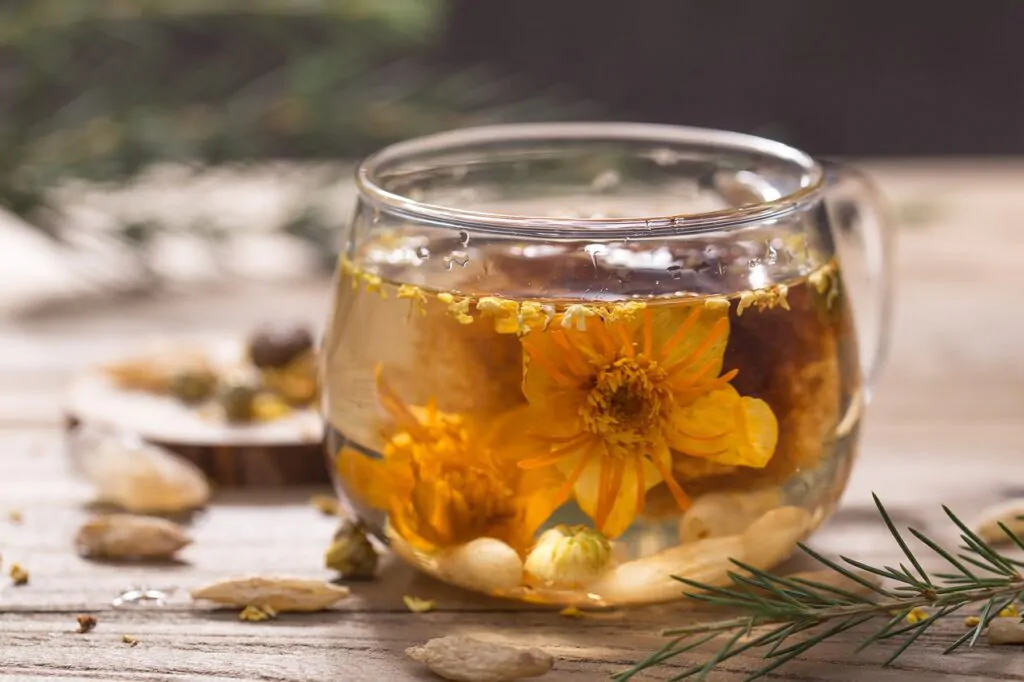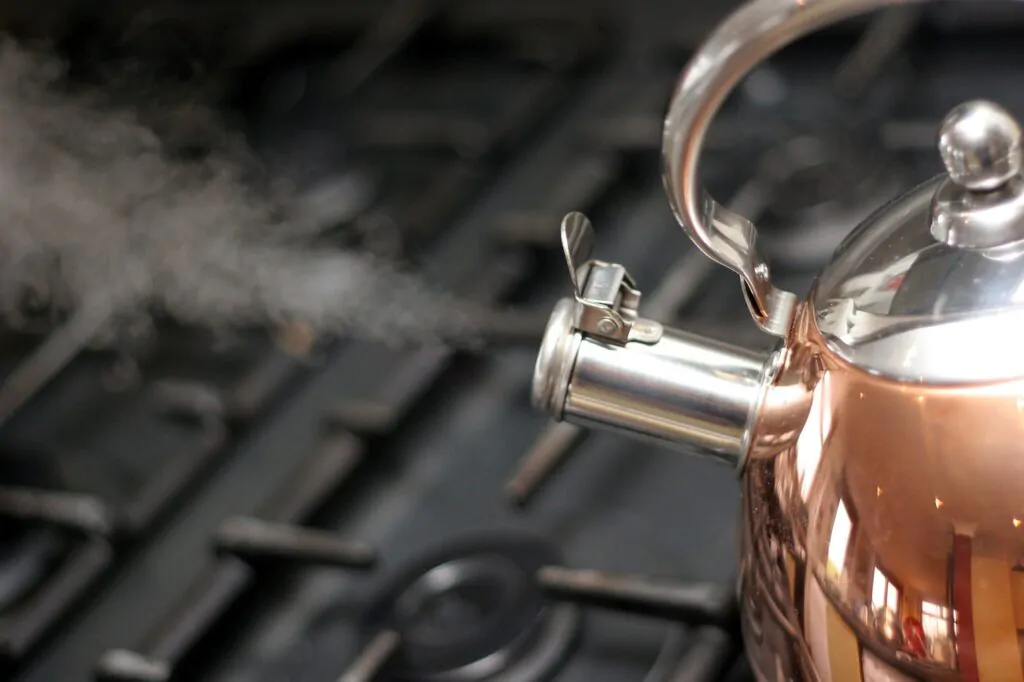Wondering what is jasmine tea and whether it’s your cup of tea? Also known as green jasmine tea, it’s a fragrant tipple enjoyed by many. Read our useful guide for the lowdown.

Are you a tea lover? With more than 159 million Americans drinking tea on a daily basis, you’re in good company. Jasmine tea is a popular choice when it comes to a cuppa; it’s one of the most famous tea blends. But what exactly is it? Continue reading to find out.
What Is Jasmine?
Perfumed jasmine flowers usually come from one of two jasmine species: Common Jasmine (Jasminum officinale) or Sampaguita (Jasminum sambac). Common jasmine is native to the Middle East; Sampaguita is indigenous to the eastern Himalayas. Both species now grow in many other countries and can be used to make tea.
What Is Jasmine Tea?
It’s a flavored tea that often has green tea as its base – hence the name jasmine green tea – but not always. The Fujian Province of south-eastern China is famed for jasmine tea gardens and production.
Jasmine teas are made from any type of tea produced from the Camellia Sinensis plant – the evergreen shrubs or small trees whose leaves and buds produce tea. For that reason, jasmine tea isn’t a herbal tea.
Regardless of the base, the tea is scented with jasmine flowers or flavorings. That transforms the tea into jasmine tea.
A green tea base is the most common, but white tea, black tea, and even oolong tea mixed with delicate jasmine blossoms are also available to buy. For instance, white tea infused with jasmine flowers is super delicate and floral.
If you buy jasmine black tea, that produces a more sophisticated tea than traditional black tea. And oolong jasmine tea is greener and lighter than standard oolong tea.
Jasmine Tea: History
Jasmine was used to scent tea more than 1,000 years ago. And drinking jasmine tea became increasingly favored during the Ming dynasty in China. The rise in popularity may have had something to do with the Ming obsession with anything floral.
Flavoring tea leaves continued during the Qing dynasty, when the likes of bergamot and orange were added to the scented tea mix.
Jasmine Tea: Scenting
There are a few methods for scenting tea leaves with jasmine:
- Natural scenting. Flowers are plucked from the jasmine plant during the day when the buds are closed. In a warm room, these are placed below a tray of loose tea leaves. The jasmine flowers begin to open and the tea leaves absorb the aromatic oils and moisture from the blossoms. The jasmine is regularly replaced during the scenting process. That gives the tea a light aroma and taste. The tea is then dried and packaged. This is an arduous and pricey method, but the result is quality jasmine tea.
- Jasmine pearls. Springtime tea buds are plucked and hand-rolled into pearl-like shapes. The pearls are then heat-infused with jasmine flowers, and the tea absorbs the subtle scent of the jasmine blossom. The scenting process is repeated up to seven times. Fresh jasmine blossoms are used each time until the optimal jasmine scent infuses. The last step is to fire the jasmine tea to stop the oxidation process and lock in the jasmine flavor.
- Blending. For this method, use the leftover, wilted jasmine flowers from the first process. Mix the dried jasmine blossoms with loose leaf tea to impart their floral scent. Remove the jasmine blossoms, dry the tea, then package it. This is a cheaper method than natural scenting.
- Artificial fragrance. Sadly, the fake nature of artificially created fragrances leaves this product lacking. Compared to the natural version, there’s no contest. Artificial jasmine blossom scent is most often used on low-quality teas. For example, mass-market bagged teas may fall into that category. Artificial flavoring makes the process easier and is suitable for long-term storage. However, the flavor suffers.
Methods one and two are considered traditional jasmine tea methods of production. Also, the time of year the base tea is plucked impacts the final product and its flavor. If picked in the spring, consisting of young, fresh leaf buds, the end tea product is naturally sweet and smooth.
Brewing Jasmine Green Tea
As with all true teas produced from the Camellia Sinensis tea bush, jasmine teas contain caffeine. They also contain the compound L-theanine. That slows the release of caffeine into the body, giving a gentle boost.
We recommend brewing at a temperature of around 80˚C or 175°F – shy of boiling water. That coaxes out the natural jasmine flavor and sweetness. If you’re using pearls, count out the expertly-rolled balls – for each brew, you’ll need 15-20 per 200ml of water.

For optimal results, use a glass teapot and watch the pearls gently unfurl. As the loose leaf tea brews, enjoy the wonderful fragrance of jasmine flowers. If you prefer, you can also buy pre-made tea bags. If you liked this post, you might be interested in reading about the best teas to drink in the morning.
Flavor Profile of Jasmine Tea
Whatever the method of production, the result is a tea with the scent of fresh jasmine flowers. Taste-wise, jasmine tea is intensely fragrant and mellow with a smooth floral taste and a hint of honey. Jasmine-scented teas also tend to be subtly sweet and refreshing.
Jasmine has a unique aroma and taste that compliments the grassy, vegetal, and nutty notes of green and white teas. The delicate flavor profile and silky-smooth mouthfeel make it a tea to enjoy both morning and afternoon.
Who Drinks Jasmine Tea?
If you’re a newcomer to the world of tea, jasmine tea is a good place to start. The subtle flavor of jasmine and the floral notes are the primary flavors you’ll taste. The taste of tea is somewhat masked.
Jasmine Tea and Sugar
Jasmine tea is perfumed and fragrant. For that reason, it often requires no sugar or honey. For comparison, drinking green tea without any sweetener can be a struggle. Why? The astringency of green teas means sugar or honey is often added.
Jasmine Tea: Price
Cost-wise, jasmine teas are slightly more expensive than green teas. With jasmine tea, lower quality tea leaves are used – loose tea leaves that are lesser grade don’t influence the flavor too much. The price is therefore lower.
So, why is jasmine tea pricier overall? Because growing and picking jasmine blossoms is expensive. However, if artificial flavorings are used instead, the price falls.
So really, it depends on the quality of the tea leaves and whether real jasmine flowers are used.
Health Benefits of Jasmine Tea
What are the benefits of drinking jasmine tea? In fact, the jasmine flower doesn’t have any particular health benefits. Jasmine tea is only as healthy as the base tea it’s made from.
For example, jasmine tea made from a base of green tea has health benefits that are in line with that of green tea. The same can be said for caffeine content.
So, what are the health benefits of jasmine green tea?
Green tea is high in polyphenols, a natural compound thought to have potential health benefits. It’s also loaded with antioxidants.
Green jasmine tea contains the catechin epigallocatechin-3-gallate (EGCG). A catechin is a natural antioxidant that may reduce inflammation and protect cells from damage by reducing harmful free radicals in the body.
Green tea may also boost brain function and fat burning, and lower bad cholesterol. And there are other health claims such as weight loss, improved digestion issues, and reduced risk of cancer and heart disease.

Note: the health benefits of jasmine tea are largely unsubstantiated by evidence. Although it’s said that tea can help with many ailments, further research needs to be carried out.
What Is Jasmine Tea FAQs
What’s jasmine tea good for?
It’s filled with antioxidants and is linked to many health benefits, depending on the base tea. For example, jasmine green tea may boost brain function and fat burning, and lower cholesterol.
Is Jasmine Tea The Same As Green Tea?
Jasmine tea is a subtype of green tea that’s been scented and brewed with the jasmine flower.
What does jasmine tea taste like?
It depends on the base tea, but generally has a delicate, floral flavor and a perfumed aroma.
The Final Word On What Is Jasmine Tea?
Tea has been around since 2700BC, so it’s not surprising that tea has global popularity. There are many types of tea leaves on the market. These include green tea, oolong tea, white tea, and jasmine tea.
Jasmine teas generally hail from China and usually have green tea as the base – hence the name jasmine green tea.
Jasmine tea is a scented tea. It’s scented in a handful of ways, from natural to artificial. Jasmine tea with jasmine oil or flavoring is deemed inferior to traditional jasmine green tea.
Taste-wise, a cup of jasmine tea has a delicate flavor. Jasmine teas are mellow, subtly sweet, and fresh, with a smooth floral flavor. And they boast a fragrant aroma.
Drinking jasmine tea may have some health benefits, but it depends on the base tea. For example, jasmine green teas may boost brain function, reduce the risk of cancer, and burn fat. That’s because the green tea base is rich in polyphenols and antioxidants.
If you fancy a cup of tea and would like to sample something a bit different, why not try jasmine tea?
